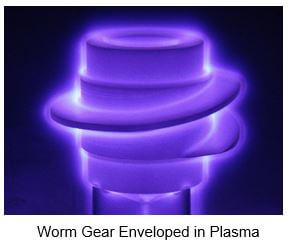Plasma Nitriding, also called Ion Nitriding, is a thermo-physical case hardening process. It is the latest advancement in Nitriding Technology.
Plasma Nitriding uses glow discharge technology to introduce elemental nitrogen to the surface of parts for subsequent diffusion. In a vacuum, high voltage is used to form plasma, and molecular Nitrogen atoms are disassociated into an atomic form and are accelerated to impinge on the part. This ion bombardment heats the workpiece, cleans the surface and drives the Nitrogen into the part surface to form Nitrides, creating a hardened case.
Plasma Nitriding provides great fatigue strength. Parts are hardened to the desired mechanical strength, prior to Plasma Nitriding. Plasma Nitriding can be accomplished as low as 800°F and is the preferred Nitriding method for parts with high harnesses often seen in tool steels. Plasma Nitriding is often combined with Black Oxide to provide added corrosion protection.

Plasma Nitriding has many advantages over traditional Gas Nitriding process.
- Primary choice for Stainless Steels. The invisible chromium oxide layer is a barrier for Nitriding ad must be removed prior to Nitriding. In Plasma Nitriding, sputtering steps remove the chromium oxide layer. As this is a vacuum process, the chrome oxide cannot grow back, providing a uniform Nitride case.
- Consistent Nitriding results, cycle over cycle. Opposed to Gas Nitriding where the furance atmosphere temperature is controlled, the Plasma Nitriding process controls the part temperature. Regardless of batch quantity, results remain consistent.
- Surfaces requiring protection from Nitriding can be masked using mechanical means (sheet masks). Application and removal of stop off paints or plating are not required.
- Minimal or no increase in the surface roughness of the part.
- Reduced coefficient of friction.
- Varying pressure dictates the degree of contour following. For example, a blind hole can be Nitrided or literally skipped over.
- No delamination or surface cracking concerns with white layer. The white layer produced in Plasma Nitriding is Gamma Phase and ductile. Plasma Nitrided gears that retain white layer are fatigue resistant, wear resistant, and corrosion resistant.
Materials Suited for Plasma Nitriding:
- Alloy Steels that are quenched & tempered: 4140, 4340, 4150, P20
- Nitriding Steels: Nitralloy 135, Nitralloy 135M
- Tool Steels: H13, H11, D2, A2, M2, S7
- Martensitic Stainless Steels: 410, 416, 420, 422
- Austenitic Stainless Steels: 303, 316, 330
- Precipitation Hardened Steels: 13-8PH, 15-5PH, 17-4PH
- Nickle Alloys: 901, 718
Advanced Nitriding Solutions is Nadcap accredited* and can certify to the AMS 2759/8 specification. Please contact us to learn about additional Aerospace OEM specification compliance.
Ion Implantation
Ion implantation is a Plasma Nitriding process designed for Stainless Steels and High Hardness Tooling. The diffusion is limited to allow case hardening on Stainless Steels without losing corrosion resistance properties, and allows High Hardness Tooling to be hardened without risking embrittlement.
